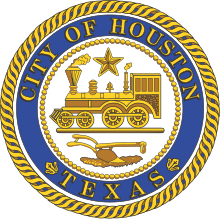Charles Bigelow (politician)
Charles Bigelow | |
|---|---|
 | |
| 4th Mayor of Houston | |
| In office January 6, 1840 – January 15, 1841 | |
| Preceded by | George W. Lively |
| Succeeded by | John Day Andrews |
| Personal details | |
| Born | July 15, 1805 Northborough, Massachusetts, U.S. |
| Died | October 27, 1885 (aged 80) Grafton, Massachusetts, U.S. |
| Spouse(s) |
Cynthia Greenwood Warren
(m. 1829; died 1849)Harriet Caroline Taft
(m. 1849) |
Charles Grafton Bigelow (July 15, 1805 – October 27, 1885) was a businessman who served a single one-year term as the fourth mayor of Houston, Texas, from January 6, 1840, to January 15, 1841, before serving as a colonel in the Mexican-American War.[1]
Bigelow Street in Houston's Near Northside neighborhood is named in his honor.
Early life
[edit]Born on July 15, 1805, in Northborough, Massachusetts, Bigelow left his hometown at age 23 to found the Northwest Territory's first tannery in Detroit.[2] On May 28, 1829, he married his first wife, Cynthia Greenwood Warren, in Northborough. They had two daughters, Sarah Warren and Agnes Louisa Bigelow, in 1831 and 1835 respectively.[1]
Career
[edit]After moving back to his home state in 1831, Bigelow conducted business in the towns of Grafton, Northbridge, Uxbridge, and Worcester before emigrating to the Republic of Texas.[2] Bigelow had arrived in Texas by November 28, 1838, when he advertised 170 acres of land for sale in the Telegraph and Texas Register.[3] Bigelow owned a farm equipment store and an ice house in Houston.[4]
On January 6, 1840,[1] Bigelow defeated incumbent George W. Lively by one vote[4] in Houston's mayoral election. During a term characterized by tension between Houston, Harris County, and rival settlements such as Harrisburg,[5] Bigelow sought to improve relations by hosting visiting dignitaries such as James Pinckney Henderson.[4] Before his term ended on January 15, 1841, Bigelow and Houston's aldermen faced many of the new city's challenges while taking measures to establish it as a leading city in, if no longer the capital of Texas.[1]

After Bigelow's authorization by the city council on February 17 to commission a seal for the young city, the Seal of Houston was drafted by Bigelow's friend[4] and former mayor Francis W. Moore, Jr. It was formally received as the city's seal during the next meeting, on February 24.[1]
Accompanied by railroad officials and community leaders on July 25, 1840, Bigelow formally began construction of the short-lived Houston and Brazos Rail Road with a spade during a groundbreaking ceremony.[6]
Maddened by a $500 annual license issued to the county's brothels, Bigelow petitioned Harris County in a lawsuit by the city to end licensing, a revenue stream supplied disproportionately by Houstonians, in favor of a property tax. Despite a legally dubious case, Judge A.B. Shelby granted an injunction temporarily halting the collection of license taxes within Houston.[5]
Later years
[edit]After his term ended on January 15, 1841,[1] Bigelow remained in the city as a businessman.[4] In 1846, served as a colonel of a Texas Regiment of Rangers in the Mexican-American War, allegedly playing a significant role in the Battle of Palo Alto.[2] In September 1849, his first wife died when the Brig Cuba was lost at sea in a gale while sailing from Galveston to New York.[1] Saddened by her death, he returned to Massachusetts,[4] where he married Harriet Caroline Taft on December 6, 1849.[1] Unionist and abolitionist sentiments were factors leading Bigelow to remain in Massachusetts,[4] where he would raise three children with his second wife, Charles, Harriet C. "Hattie", and Charles Sam Houston "Texas Charley" Bigelow.[1]
Death
[edit]Bigelow died at age 80 on October 27, 1885, in Grafton, Massachusetts. He is buried in Worcester, Massachusetts.[7]
References
[edit]- ^ a b c d e f g h i Shuffield, Lynna Kay (2014). Houston, Harris County, Texas : mayors during the Republic of Texas, 1836–1846 and the co-founders, a collection of biographical, death & burial information. Houston, Texas. pp. 75–83.
{{cite book}}: CS1 maint: location missing publisher (link) - ^ a b c Pierce, Frederic Clifton (1879). History of Grafton, Worcester county, Massachusetts, from its early settlement by the Indians in 1647 to the present time, 1879. Including the genealogies of seventy-nine of the older families. Cornell University Library Annex: Worcester : Press of C. Hamilton. pp. 461–462.
- ^ Cruger & Moore. Telegraph and Texas Register (Houston, Tex.), Vol. 4, No. 16, Ed. 1, Wednesday, November 28, 1838, newspaper, November 28, 1838; Houston, Texas. (https://texashistory.unt.edu/ark:/67531/metapth48023/m1/1/?q=bigelow: accessed October 10, 2019), University of North Texas Libraries, The Portal to Texas History, https://texashistory.unt.edu; crediting The Dolph Briscoe Center for American History.
- ^ a b c d e f g Benham, Priscilla (1998) "Houston Mayors: Developing a City," East Texas Historical Journal: Vol. 36: Iss. 1, Article 11.
- ^ a b WEISEL, EDWARD BERRY. “CITY, COUNTY, STATE: INTERGOVERNMENTAL RELATIONS IN TEXAS, 1835–1860.” N.p., 1975. Print.
- ^ Werner, George C. (March 20, 2017). "Houston and Brazos Rail Road". Texas State Historical Association. Archived from the original on October 15, 2019. Retrieved October 14, 2019.
- ^ Collier, Jo (April 27, 2017). "Charles Grafton Bigelow". Handbook of Texas Online. Retrieved October 19, 2023.
